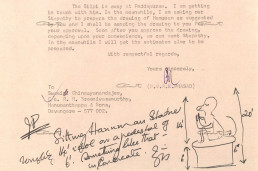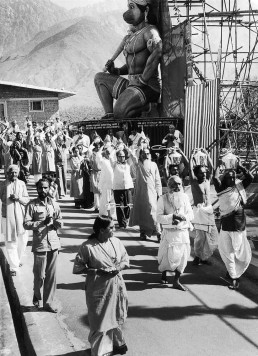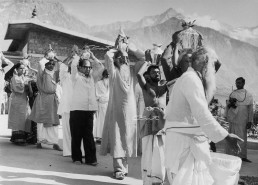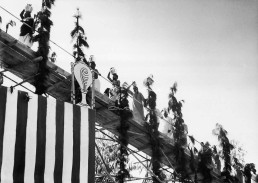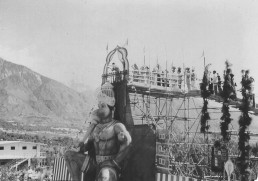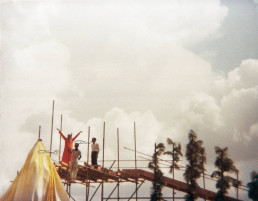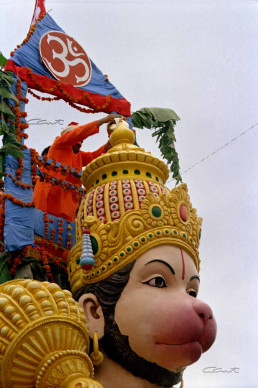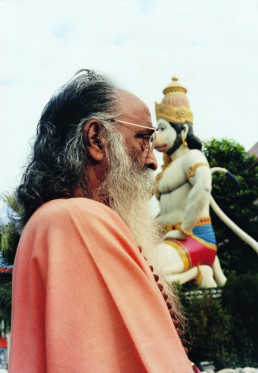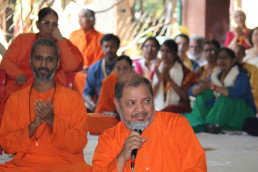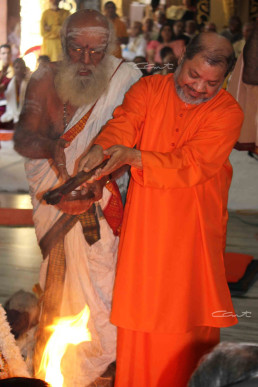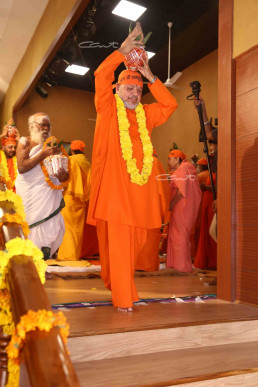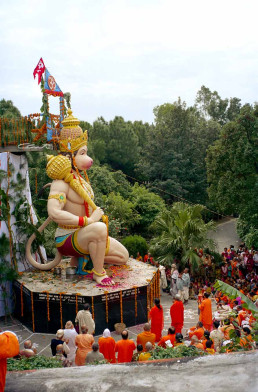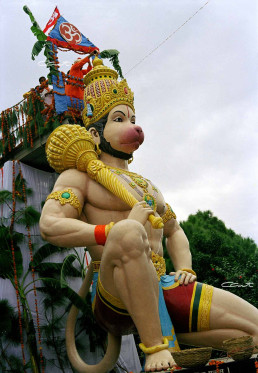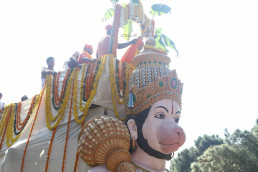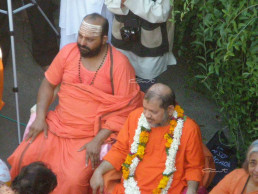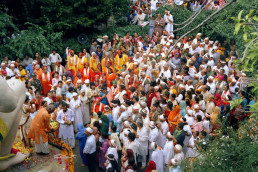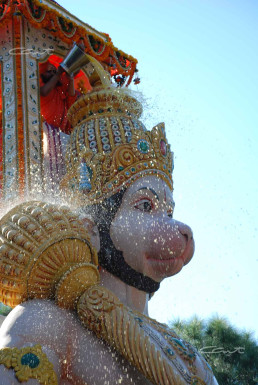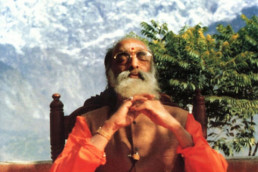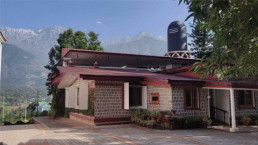
Introduction
Awe-inspiring, alert, and magnificent, Vayuputra Shri Hanuman is a powerful presence in the Chinmaya ashram at Sidhbari. Calming the gusty winds across an open landscape with His powerful yet compassionate glance, the majestic Lord sits in veerasana ready to serve both Shri Ram whom He holds in His heart and the devotees who adore and approach Him.
It was the vision of Pujya Gurudev Swami Chinmayananda that sketched the arrival of the 22-feet idol of Shri Hanumanji at Sidhbari. Seeing how the fertile land of Sidhbari stood bare because of the strong winds, Pujya Gurudev invoked the Presence of Vayuputra Hanuman. His simple sketch in a letter (1981) to a longtime devotee marked the birth of the 16-feet towering idol atop a 6-feet pedestal. Gurudev knew – where the son will be, the Wind-God father will move with gentle affection! Thus was invited Vayuputra Shri Hanuman to watch over the Sidhbari ashram as construction progressed smoothly.
Facts
CONSECRATION
October 10th, 1982
DESIGN
Initial sketch by Pujya Gurudev
Prototype and Sculpture by Shri Kashinath Shilpi
Statue: 16-feet
Granite Base: 6-feet
NOTES
Verses from Tulsi Ramayana selected by Pujya Guruji adorn the granite base.
Over 5,000 attended the first Mastakabhishekam.
HISTORY
Every five years, a Mastakabhishekam is performed to Lord Hanuman at Sidhbari. Below is a brief chronicle of this momentous event over time.
In 1982, when Shri K. Kashinath Shilpi had completed the construction of the idol (here is a transcript of the interview with Shri Kashinath), Pujya Gurudev planned the first Mastakabhishekam to consecrate and invoke the power of Lord Hanuman into the beautiful idol seated under the open skies according to Vedic traditions. To perform an abhishekam (the divine bathing ceremony) from the crown to feet of the towering idol that rose about 22 feet, a ramp that extended over 90 feet from the ground to the top was erected by the army personnel of Yol Cantonment. It was decorated by pine tree branches carefully picked with devotion and reverence to Nature. The energetic Chyks from Chennai led by Swami Siddhananda were a great help in this inaugural consecration.
The rituals began on October 8, 1982. As the Vedic vibrations filled the air, Pujya Gurudev guided all devotees to a continued chanting, “Om Sri Ramadhootaya Namaha.” Br. Vivek Chaitanya (now Swami Tejomayananda) added the melody of devotion inspiring them to also sing the Hanuman Chalisa. When lightning and thunderous rains filled the skies two days before the abhishekam, Pujya Gurudev Swami Chinmayananda remarked: Perhaps Varuna and Indra wanted to do the abhishekam first and give their benediction!
October 9 was a pious day of homams and kalasa sthapana. Thousand and one kalasas (pots) in gold, silver, brass, stainless steel, copper, mud filled with either water from Ganga or milk, curd, turmeric or sindhoor were divinized with invocations and worship (Aavaahanam and Sahasra Archana). As those rituals concluded, Sri Hanumanji’s idol was unveiled that evening after Arati.
When October 10th dawned, the Mastakabhishekam drew about five thousand people worldwide, including army personnel, government officers, and joyful people from the villages that surrounded the beautiful Sidhbari. As the priests followed by Pujya Gurudev, dignitaries, and devotees walked up the ramp with the sanctified Kalasas to perform the abhishekam, bathing Lord Hanuman’s form from crown to foot, the entire gathering was immersed in devotion with reverential chanting. Worship (Archana) with adornment (Alankara) and arati culminated with a long vada mala offered to the newly consecrated lustrous Lord; Vayuputra Hanuman stood blessing all of Sidhbari.
That first abhishekam on October 10, 1982, marked the onset of the 5-year tradition surrounding Shri Hanumanji at Sidhbari.
With the holy waters from the Ganga of Haridwar, the Kalasas were anointed as the homam rituals again purified the air to mark the 5-year milestone after the first consecration of the Sidhbari Vayuputra. It was a heartwarming sight to watch Pujya Gurudev Swami Chinmayananda race up the ramp which was built by the local villagers.
Pujya Gurudev led the Abhishekam procession energized by the sonorous chants of “Om Sri Ramadutaya Namaha.” Fireworks lit up the skies as the procession moved from the idol of the greatest Sevak Hanumanji to also perform the Abhishekam of His Master, the Supreme Lord Vanavasi Rama and Mother Sita at the Rama Mandir in Sidhbari.
This was the last Mastakabhishekam performed by Pujya Gurudev before His mahasamadhi in 1993.
Held a day after the memorable Vivekachoodamani camp of Pujya Gurudev, the third Mastakabhishekam was marked by elaborate preparations and excellent support by an earnest group of army personnel from the Yol cantonment who had erected an iron ramp and railing for the abhishekam. A sacred ceremony of Kalasa sthapana was followed by another hallowed reconsecration ceremony that filled hearts with grateful devotion toward the imposing guardian Lord of Sidhbari.
Set inside a beautiful mantap, 390 kalasas were brimming with the holy waters from the Manasarovar to the southern rivers and seas. Vedic scholars from Delhi (led by Sri Subbarama Shastri) initiated the ceremony with elaborate homams and performed puja to those kalasas. Notable were the three Pradhana Kalasas – for Lord Rama, Lord Hanuman, and one honoring Pujya Gurudev Swami Chinmayananda who had attained Mahasamadhi in 1993. When Pujya Guruji Swami Tejomayananda and other acharyas offered abhishekam with the sanctified waters, it was as though Tejasvi Hanuman was beaming down on the hundreds of devotees. As Hanumanji glowed even more in the Arati after vastra (new clothes) and garlands were offered, a gentle rain from the skies seemed to carry the joy of the heavens down to Sidhbari.
The skies over Sidhbari poured in anticipation, two days before the 5th mastakabhishekam in 2002. On the day of the abhishekam, priests carried the three Pradhana Kalasas from Kamala Hall while Pujya Guruji Swami Tejomayananda and the acharyas held the kalasas on their heads and performed the Mastakabhishekam amid devoted, enthusiastic chanting of Om Sri Ramadutaya Namaha. Later, as the face of Shri Hanuman shone in the Arati, the sun smiled between the parting clouds as if joining the celebration to delight all.
After gaining inspiration from Pujya Guruji’s camp on Hanuman Chalisa, the silver jubilee Mastakabhishekam started off melodiously with a musical concert by Pandit Jasraj. Then began the Vedic preparatory rituals of pujas and homams under the leadership of Shri Subbarama Shastri as four Pradhana Kalashas ready to be specially offered to Sri Rama, Lord Shiva, Lord Hanuman, and Pujya Gurudev adorned the top of the pyramid of 1000 kalasas.
Everyone wanted to offer their best to Shri Hanumanji – the Indian Army built a special ramp with much devotion; specialists from Brindavan, at Swamini Gurupriyananda’s request, decorated the place with flowers. When Pujya Guruji led the Mastakabhishekam procession in an atmosphere of fervent chanting and joyful Pahadi Bhajans, Shri Hanumanji’s face reflected the joy of His devotees. The special offerings of garlands, tulsi mala, angavastram, silver anklets, and a gold-embossed red belt with “Sri Ram Jay Ram ” lettered on it added the festive silver touch to the glowing Lord.
Keeping with the Vedic traditions, the 7th reconsecration ceremony was performed with great devotion and delight under the leadership of Pujya Guruji. The faithful gathering of villagers, army personnel, and devotees gazed on at the mesmerizing form of the mighty Shri Hanumanji during the Mastakabhishekam. When beautiful flower petals were showered on the huge form of the Lord after the ceremony, all hearts were bathed in great happiness.
In 2017, Mukhya Swami Swaroopananda performed the 8th Mastakabhishekam in the presence of Pujya Guruji Swami Tejomayananda.Once again, the unbroken chanting of “Om Sri Ramadutaya Namaha” and Anjaneya Sahasranama Archana sanctified the air as kalasa pujas and homams were performed by Sri Subbarama Shastri and his team. The abhishekam, as always, transported everyone who witnessed it into a realm of deep devotion that was colored with great joy when beautiful flowers were showered on Shri Vayuputra! The Lord continued to shine with new clothes, fragrant garlands, and a long pearl necklace that gained beauty because of adorning His luminous Form. It was a spectacular ceremony, and we present highlights of that 2017 consecration event.
The ninth Mastakabhishekam of Sri Veera Hanuman at Sidhbari was conducted in a memorable ceremony that spanned the days of Oct.8-10, 2022. The celebratory worship began on Oct.8 with great prayers offered during the Anjaneya Utsava Murthy puja. The eyes and hearts of all devotees were riveted on the resplendent idol of Shri Hanuman throughout the beautiful abhishekam as Swami Sharadananda conducted the elaborate puja. Following that, the Guru Puja at Pujya Gurudev’s Samadhi Sthal and the Guru Anugnya paada pujas of Pujya Guruji and Pujya Swami Swaroopanandaji indicated how the Grace of the Chinmaya Guru Parampara would be the guiding force for this Mastakabhishekam.
During the Kalasha Sthapana rituals, the colorful backdrop of the ceremonial pots signifying the five elements of space, air, fire, water, and earth was meaningful and eye-catching. The Vedic homams culminating with the purnahuti, and the rituals of Sri Rama Sahasranama Archana and Sri Hanuman Sahasranama Archana purified and permeated the entire surroundings in the ashram setting the stage for a grand Mastakabhishekam. On the chill and misty morning of Oct.10th, when Pujya Guruji and Pujya Swami Swaroopanandaji performed the Mastakabhishekam of the majestic Lord Hanuman with Panchamruta, turmeric and kumkum waters, all devotees onsite and online were moved by the divine beauty of the reconsecration ceremony in the scenic Sidhbari. Melodious bhajans by Pujya Guruji, Swamins, students of the 18th Vedanta course, devotees, and the Pahadi people added joy. The happy Garbha dances that brought people from far and near together added the sweet touch of happiness. Then, as the long line of devotees performing the abhishekam ended, the glowing idol of Vayuputra Hanuman was adorned with a beautiful garland and a bright saffron angavastram. When the festivities ended with Sri Hanuman Arati, it was evident that the 9th Mastakabhishekam had bathed and blessed all who witnessed it with joyful, grateful devotion.
Mastakabhishekam Videos
Related Topics
Related Topics
Sidhbari Intro
In this module, we attempt with a prayer to highlight the beautiful landmarks and special events at Sidhbari that enrich Chinmaya Mission worldwide.
Sidhbari, Hanumanji, and Gurudev
The story of how Sidhbari, Pujya Gurudev, and Hanumanji came together is a story of persistence, penance, harmony, and devotion. When He recognized…
Sidhbari Kutiya
A focal point of Sidhbari, Pujya Gurudev’s Kutiya holds deep meaning for devotees and spiritual seekers. In this section, we present important…
